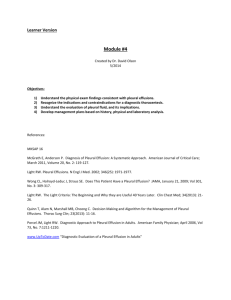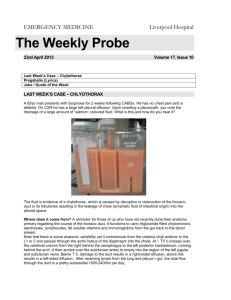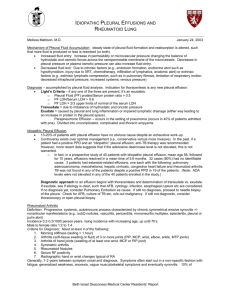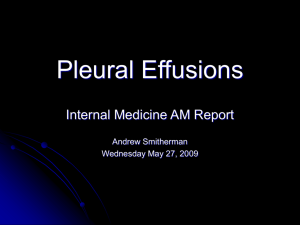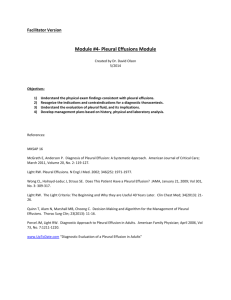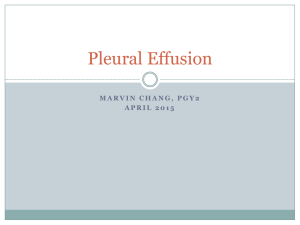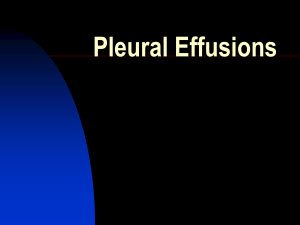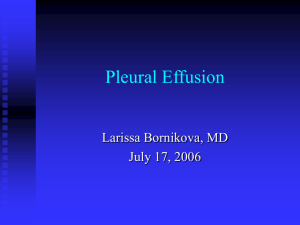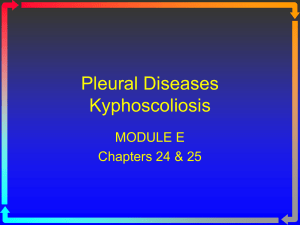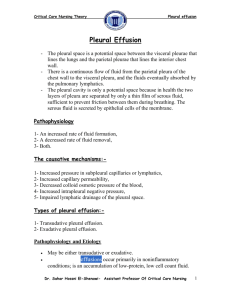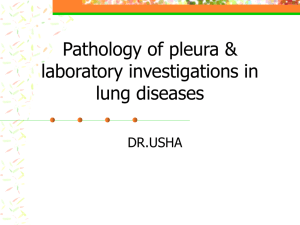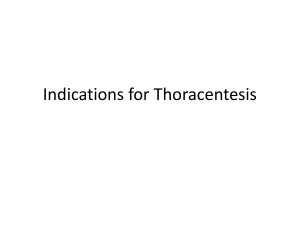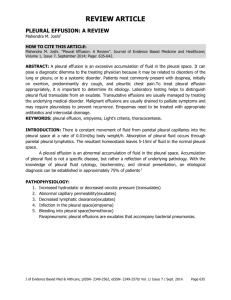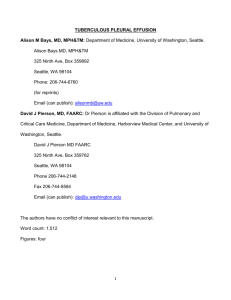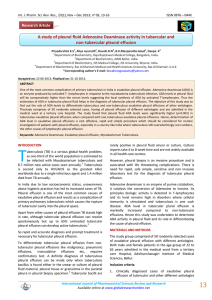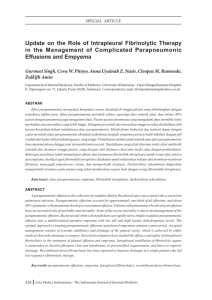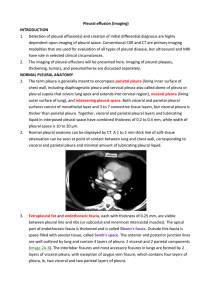Exudative Pleural Effusion Phenotype by Three-Test Rule
advertisement
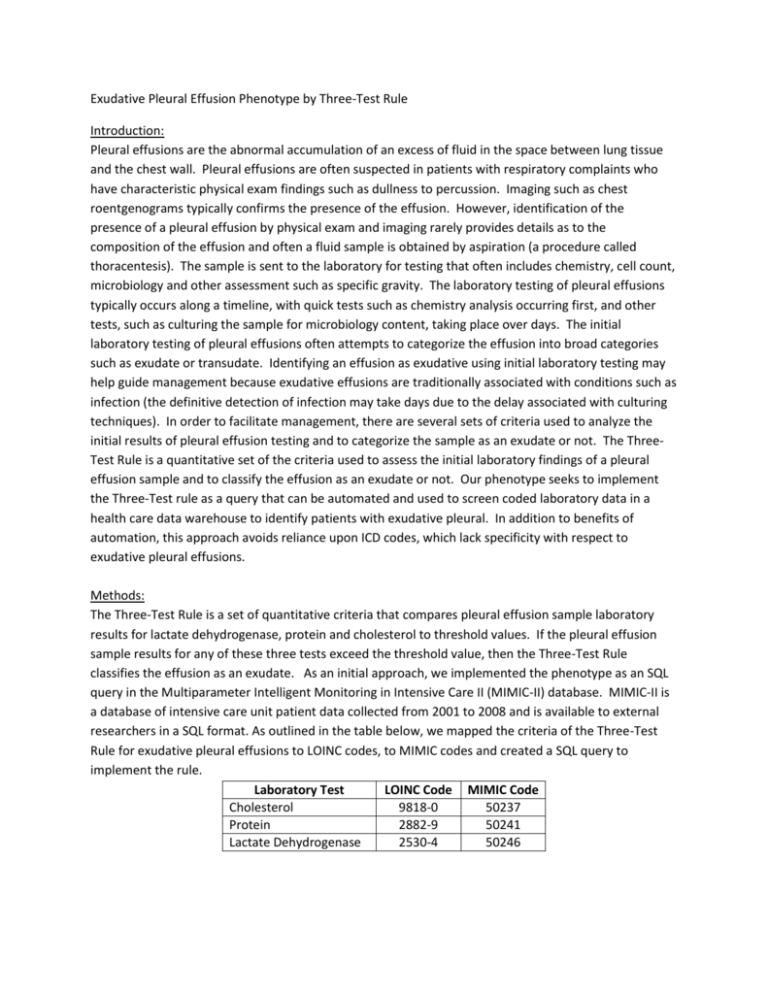
Exudative Pleural Effusion Phenotype by Three-Test Rule Introduction: Pleural effusions are the abnormal accumulation of an excess of fluid in the space between lung tissue and the chest wall. Pleural effusions are often suspected in patients with respiratory complaints who have characteristic physical exam findings such as dullness to percussion. Imaging such as chest roentgenograms typically confirms the presence of the effusion. However, identification of the presence of a pleural effusion by physical exam and imaging rarely provides details as to the composition of the effusion and often a fluid sample is obtained by aspiration (a procedure called thoracentesis). The sample is sent to the laboratory for testing that often includes chemistry, cell count, microbiology and other assessment such as specific gravity. The laboratory testing of pleural effusions typically occurs along a timeline, with quick tests such as chemistry analysis occurring first, and other tests, such as culturing the sample for microbiology content, taking place over days. The initial laboratory testing of pleural effusions often attempts to categorize the effusion into broad categories such as exudate or transudate. Identifying an effusion as exudative using initial laboratory testing may help guide management because exudative effusions are traditionally associated with conditions such as infection (the definitive detection of infection may take days due to the delay associated with culturing techniques). In order to facilitate management, there are several sets of criteria used to analyze the initial results of pleural effusion testing and to categorize the sample as an exudate or not. The ThreeTest Rule is a quantitative set of the criteria used to assess the initial laboratory findings of a pleural effusion sample and to classify the effusion as an exudate or not. Our phenotype seeks to implement the Three-Test rule as a query that can be automated and used to screen coded laboratory data in a health care data warehouse to identify patients with exudative pleural. In addition to benefits of automation, this approach avoids reliance upon ICD codes, which lack specificity with respect to exudative pleural effusions. Methods: The Three-Test Rule is a set of quantitative criteria that compares pleural effusion sample laboratory results for lactate dehydrogenase, protein and cholesterol to threshold values. If the pleural effusion sample results for any of these three tests exceed the threshold value, then the Three-Test Rule classifies the effusion as an exudate. As an initial approach, we implemented the phenotype as an SQL query in the Multiparameter Intelligent Monitoring in Intensive Care II (MIMIC-II) database. MIMIC-II is a database of intensive care unit patient data collected from 2001 to 2008 and is available to external researchers in a SQL format. As outlined in the table below, we mapped the criteria of the Three-Test Rule for exudative pleural effusions to LOINC codes, to MIMIC codes and created a SQL query to implement the rule. Laboratory Test LOINC Code MIMIC Code Cholesterol 9818-0 50237 Protein 2882-9 50241 Lactate Dehydrogenase 2530-4 50246 We coded the Three-Test Rule for exudative pleural effusion classification as a SQL query (PostgreSQL) for use in the MIMIC-II dataset as follows: (-- pleural fluid cholesterol criterion select subject_id from labevents where itemid = '50237' and valuenum > 45 group by subject_id union -- pleural fluid protein criterion select subject_id from labevents where itemid = '50241' and valuenum > 112.5 group by subject_id union -- pleural fluid lactate dehydrogenase criterion select subject_id from labevents where itemid = '50246' and valuenum > 2.9 group by subject_id) intersect (-- age criterion to select patients above 2 years old select ad.subject_id from admissions ad, d_patients dp where ad.subject_id = dp.subject_id and months_between(ad.admit_dt, dp.dob)/12 > 2) Results: We successfully used the SQL query implementing the Three-Test Rule for classification of exudative pleural effusions to screen the MIMIC-II dataset for a cohort of patients meeting criteria. Discussion: The clinical utility of classification systems for exudative pleural effusions is based partly on timing. When a patient undergoes thoracentesis to obtain a fluid sample of the pleural effusion, the laboratory tests needed to use the Three-Test Rule can be done quickly, and the classification of an exudate can be used to suggest the possibility of conditions that may require urgent treatment, such as empyema (infection). The use of criteria such as the Three-Test rule allows the patient to start treatment with a presumptive diagnosis based on clinical conditions and the results of the Three-Test Rule, rather than wait days for more definitive results (such as microbiology cultures) to become available. Because the MMIIC-II dataset has additional information, such as whether or not an infection was detected in the fluid sample of the pleural effusion, we hope to enhance our work with this phenotype by comparing the classification based on an SQL query implementation of the Three-Test Rule with a comparison to the available follow up test results (such as microbiology culture results). References: 1. Saeed M, et. al., Multiparameter intelligent monitoring in intensive care II (MIMIC-II): A publicaccess ICU database. Critical Care Medicine 2011;39(5):952-960 2. Heffner JE, Diagnostic evaluation of a pleural effusion in adults: Initial testing. In: UpToDate, Sahn SA. UpToDate. Waltham, MA (Accessed on March 2014) John Kimbrough Vojtech Huser
